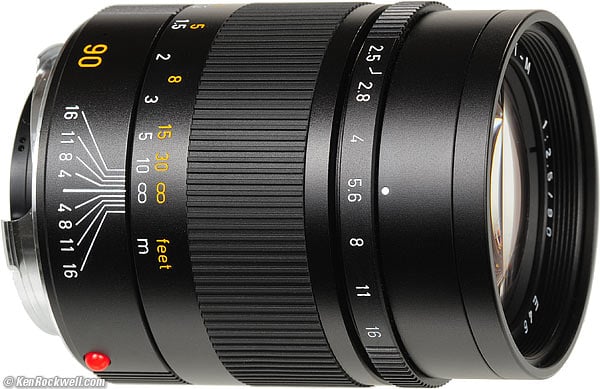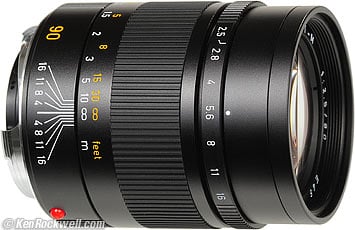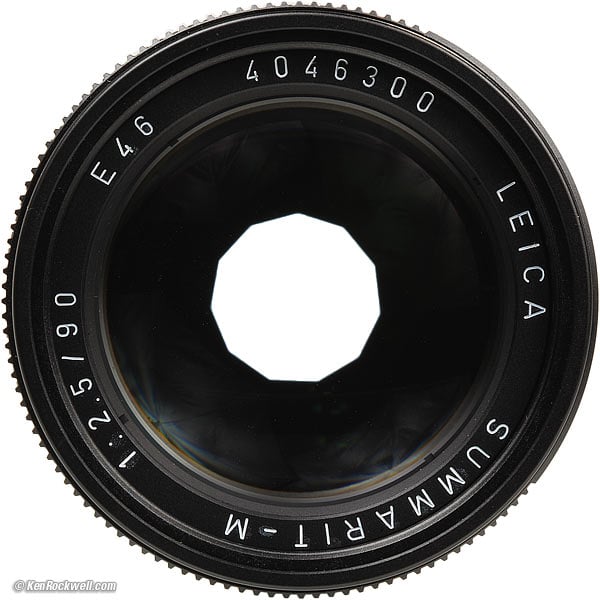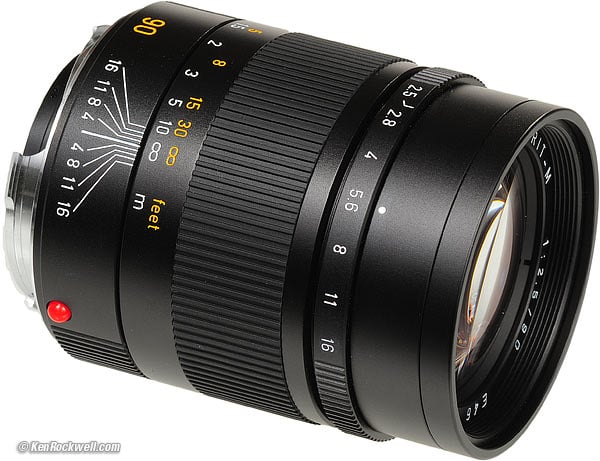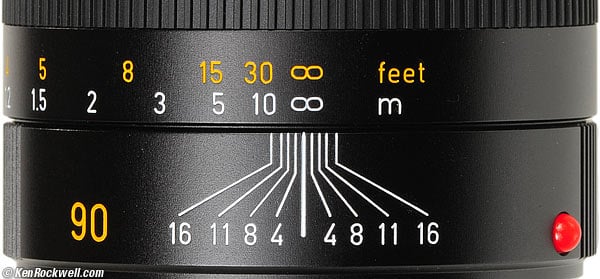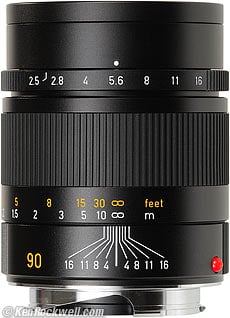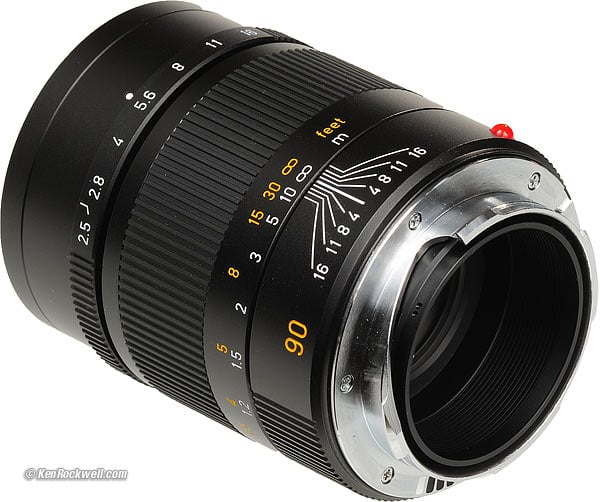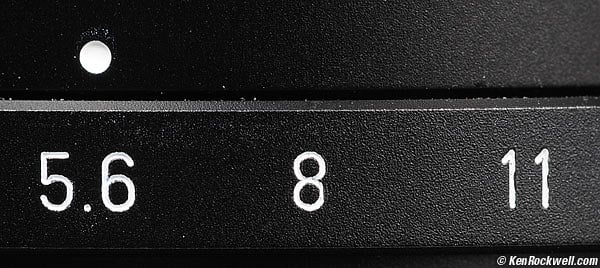Home Donate New Search Gallery How-To Books Links Workshops About Contact
LEICA 90mm f/2.5
SUMMARIT-M 11646 (2008-)
© 2010 KenRockwell.com. All rights reserved.
Intro Specs Performance Usage Compared Recommendations
More LEICA Reviews LEICA 90mm f/2.8 Lenses Compared
LEICA 90mm f/2.5 SUMMARIT-M (46mm filter, 12.140oz./344.2g). enlarge. I got this one at Adorama; Amazon also sells them. It helps me keep adding to this site when you get yours from these links, thanks!
May 2009 LEICA 90mm f/2.8 Lenses Compared
LEICA Camera Reviews LEICA Lens Reviews Recommended Lenses
LEICA Lens Names How to Afford Anything
| Optics: | |
| Mechanics: | |
| Ergonomics: | |
| Usefulness: | |
| Availability: | |
| Overall: |
Ideal Uses
A great 90mm lens for any LEICA M camera.
Not for
The man who appreciates quality or thrift. You can buy better used lenses for a fraction of the price.
Introduction top
Intro Specs Performance Usage Compared Recommendations
|
I personally buy from Adorama, Amazon, Ritz, B&H, Calumet and J&R. I can't vouch for ads below.
|
This LEICA 90mm f/2.5 SUMMARIT-M has absolutely superb optics.
It is identical in actual performance to the recently discontinued 90mm f/2.8 ELMARIT-M (46mm filter, 13.940 oz./395.15g) and today's 90mm f/2 APO ASPH (55mm filter, 16.675 oz./472.77g).
It is an ideal lens for someone who only buys new and has less than $3,500 to spend.
The 90mm f/2.5 SUMMARIT-M is not made to LEICA's usual mechanical standards. It does not use LEICA's supremely legible and beautiful square, proprietary LG 1050 font used on all its other lenses and cameras; it uses an uglier rounded font dug up from the past.
It is not for the LEICA Man who demands nothing less than the best, which is the 90mm f/2 APO ASPH.
I bought one and returned it. Compared to any other LEICA lens made in the past 50 years or more, the f/2.5 SUMMARIT-M is dinky.
The focus feel of this SUMMARIT-M lens is inferior. Unlike the smooth precision demonstrated by every other past LEICA lens, even if it's over 50 years old, the focus of the SUMMARIT-M I bought was uneven and almost gritty.
The focus grip is rubber. Unlike the superior metal ribbing of true LEICA lenses, I have no idea how well the rubber will hold up after decades of use.
The f/2.5 SUMMARIT-M isn't for practical photographers because they can buy the superior 90mm f/2.8 ELMARIT-M used for less than half the price of a new or used f/2.5 SUMMARIT-M.
Since the future resale value of the f/2.5 SUMMARIT-M should drop quickly, I see little reason to buy it, since it is of inferior construction quality compared to the older used lenses.
If you need to buy only new, sure, get one of these SUMMARIT-M lenses, but don't expect to get your money out of it when or if you go to trade it in.
Optically it is perfect; but mechanically, it is not LEICA. LEICA is the best, so if this lens is not the best, it is not LEICA. No one buys a LEICA to be second best.
Nikon tried this same "let's make cheap but optically good lenses with our name on it" with the Nikon Series E lenses back in the 1980s. They, just like Minolta's Celtic lenses, were a flop for the same reason: no one pays for a premium brand to get second-rate mechanics.
I prefer to use the 90mm f/2.8 LEICA TELE-ELMARIT-M (39mm filter, 7.957 oz./225.6g), which is smaller and lighter, or the exotic LEICA 90mm f/2 APO-Summicron-M ASPH when I need speed and don't mind the size and weight. The TELE-ELMARIT-M only cost me $400 used, and heck, the 90mm f/2 APO ASPH only cost me $1,450, used, still in the box! I see no reason to pay $1,600 for a new SUMMARIT-M.
The f/2.5 SUMMARIT-M is optically unbeaten, but I'll be darned if I'm going to pay $1,600, or even $900, for one, when the mechanically superior 90mm f/2.8 ELMARIT-M sells used for $650 over eBay.
Just as many elephants in Africa have their tusks preemptively chopped off by do-gooders to protect them from other poachers, LEICA is doing photographers of the future a favor with the SUMMARIT-M lenses. By making these lenses too cheaply to be of interest to the collectors of the future, they will become cheap enough, along with their superb optics, to become very useful for actual shooting in 10 or 20 years.
See LEICA 90mm f/2.8 Lenses Compared to make sense out of all these lenses.
Actual Size introduction top
Presuming you have a standard 106 DPI monitor, this is its actual size, which is 2.62" (66.5mm) long:
LEICA 90/2.5 SUMMARIT-M, actual size. enlarge.
The illustrations in this review have been enlarged to fit the page.
History introduction top
See LEICA 90mm f/2.8 Lenses Compared.
Specifications with commentary top
Intro Specs Performance Usage Compared Recommendations
Name Focal Length Angle-of-View Optics Diaphragm
Filter Thread Close Focus Case Caps Hood
Size Weight Part Numbers Price
Name specifications top
LEICA calls this the LEICA SUMMARIT-M 90mm f/2.5, model number 11 646.
SUMMARIT-M means nothing except a low-cost LEICA-brand f/2.5 lens.
M means it fits the eternal M series of LEICA rangefinder cameras, as well as the Voigtländer Bessas, Zeiss Ikons and Minolta CLE.
Focal Length specifications top
Actual (design) Focal Length: 91.0mm.
(Equivalent on the old LEICA M8 (half-frame): 120mm.)
(Equivalent on the Epson R-D1x (half-frame): 135mm.)
Angle of View (full-frame 35mm) specifications top
27º Diagonal.
23º Horizontal.
15º Vertical.
Optics specifications top
5 elements in 4 groups.
Multi coated.
Diaphragm specifications top
11 blades.
LEICA 90mm f/2.5 SUMMARIT-M at f/5.6. enlarge.
Stops down to f/16 with half-stop clicks.
While you're here, notice that the white paint wasn't completely removed from the parts of the lens around the lettering that are supposed to be black.
Filter Thread specifications top
46mm.
Germans call this E46 and 46E, but it's the same standard 46mm (0.75mm pitch) filter that's available everywhere.
There is a weird screw-on dummy ring that sits-in for the not-included lens hood that often impedes the attachment filters; remove it if it does.
Close Focus specifications top
Marked: 3.5 feet and 1 meter.
Case specifications top
Unlike real LEICA lenses, no case is included.
You get a cloth pouch instead, wow.
Caps specifications top
LEICA's current part number for the included metal slip-over cap is 14 475, which sells separately for $35.
The rear cap is the standard 14 269, $27 if lost.
There is a weird dummy ring that sits in for the optional hood. If you leave this metal ring on the front as the lens comes delivered, you'll have problems using regular 46mm caps.
Hood specifications top
There is no hood included.
The hood is an extra-cost ($85) option, part number 12 460, which includes a dedicated 14 477 cap. If you lose the dedicated 14 477 cap, it costs $35 to replace.
If you buy the hood, you must unscrew the dummy ring that ships in its place (cleverly called "thread protection ring" by LEICA who could have thrown in the hood for the same amount of effort) and then screw the hood over the outside of the lens. You can store the hood screwed-on backwards.
Boy, this will make changing filters a pain!
Size specifications top
LEICA specifies 2.62" long by 2.17" diameter (66.5 x 55mm).
Weight specifications top
I measure 12.140oz. (344.2g), naked.
LEICA specifies "approx. 360g."
Product Numbers specifications top
Black Lens, complete
Includes boxed lens, threaded dummy ring for hood, cloth sack, caps and paperwork.
Dummy Hood Ring (replacement)
421-091.001-007.
Front Cap (replacement)
14 475 ($35).
Rear Cap (replacement)
14 269 ($27).
Cloth Sack (replacement)
439-614.060-000.
Price specifications top
2010, April, USA: $1,700.
2009, May, USA: $1,600. THere was also an additional $300 rebate available through most of 2009.
LEICA 90 2.5 SUMMARIT-M. enlarge.
Performance top
Intro Specs Performance Usage Compared Recommendations
Overall Aperture Ring Coma Depth-of-Field Scale
Diaphragm Linearity Distortion Ergonomics Falloff
Filters Focus Lateral Color Mechanics Sharpness
Overall performance top
This LEICA 90mm f/2.5 SUMMARIT-M is sharp and contrasty, even at f/2.5.
It handles great, if you aren't familiar with the feel of real LEICA lenses.
Focus is fast, if not as smooth as better LEICA lenses.
Your biggest limitation to sharpness is the simple fact that most samples of LEICA and other rangefinder cameras have rangefinders that are not perfectly adjusted, meaning you will probably need to have your dealer (no, not you or a friend) professionally adjust your camera for optimum focus with your sample of lens.
Aperture Ring performance top
The aperture ring is perfect, like most current LEICA lenses.
One fingertip is all you need to adjust it by feel.
Coma performance top
This Leitz 90mm f/2.5 SUMMARIT-M has no coma. Coma is when points of light in the corners grow into weird-shaped blobs.
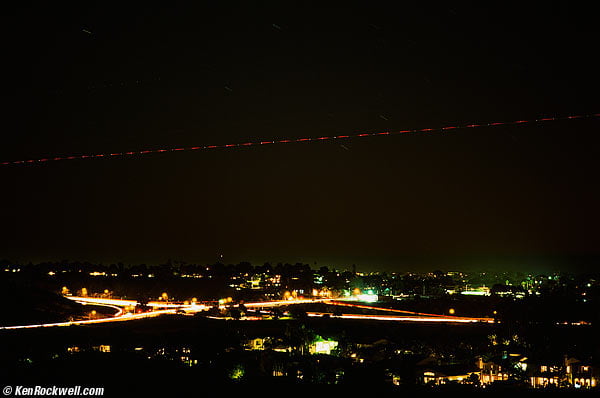
Full image, f/2.5. LEICA 90mm on Fuji Velvia 50, 104 seconds at f/2.8.
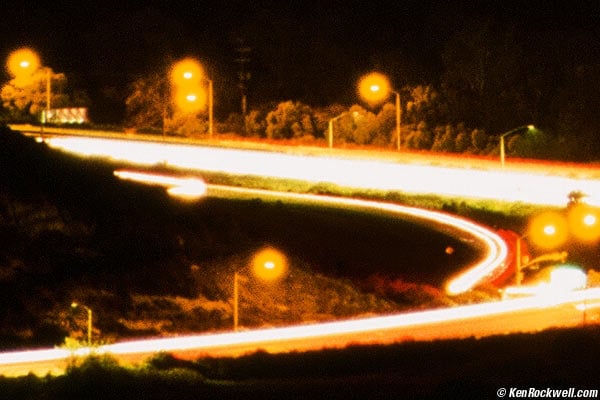
Crop from lower left of above 3600 DPI scan at 100%.
This is a crop from an 0.17" x 0.11" (4.2 x 2.8mm) section of the image. If the entire image was shown at this magnification, it would be a 32" x 48" print!
Depth-of-Field Scale performance top
Depth of Field Scale, LEICA 90mm f/2.5 SUMMARIT-M. enlarge.
The depth of field scale is so tight that it's just about useless.
The 90mm f/2 APO has a far more useful scale, because it's a bigger lens.
Diaphragm Linearity performance top
The diaphragm is linear enough, considering that the only people who will buy this lens are probably going to be using it on cameras with TTL metering.
Distortion performance top
Distortion is invisible. It's a little better than the 90mm f/2.8 ELMARIT-M, but I can't see any of this without instruments. Neither this or the 90mm f/2.8 ELMARIT-M have any visible distortion.
For critical use, use these -0.25 values in Photoshop's Lens Distortion Filter to correct the invisible pincushion distortion at infinity. I didn't measure at other distances.
Ergonomics performance top
LEICA 90/2.5 SUMMARIT-M (actual size at 106 DPI). enlarge.
Ergonomics are pretty good, if you can get over the sloppier focus feel and bizarre hood and filter ring arrangement.
The aperture flicks with a fingertip.
I'd use two fingers for focus.
Falloff (darkened corners) performance top
Falloff is moderate at f/2.5, and gone by f/4.
This is as expected for a short tele.
Per LEICA's data (page 69), falloff is 1.44 stops at f/2.5, 1/2 of a stop at f/4 and 1/4 of a stop at f/5.6. This is a bit worse than the 90mm f/2.8 ELMARIT-M.
Filters, use with performance top
There is a weird dummy ring that sits on the front of the lens to cover the external threads which mate with the extra-cost hood.
If you don't remove this ring, you have to thread filters inside of it to attach them to the lens.
The dummy ring's inside diameter is 48.6mm. Most Hoya and Heliopan filters fit OK, but normal polarizers and Contax filters won't fit with the dummy ring because their outside diameters are too big.
If you take off the dummy ring, any 46mm filter works great. You can even stack a couple with no problem.
I have no idea what happens if you buy and try to use the hood at the same time. Beware.
Focus Accuracy performance top
One of the weakest things about rangefinder cameras is getting precise and accurate focus with long lenses.
Most rangefinder cameras I see, regardless of being LEICA, Zeiss, Mamiya, Nikon, Canon or Minolta, need their rangefinders adjusted by a pro to get them perfectly in line.
Every body and sample of this lens I've tried gives different results, if you expect perfect focus at f/2.5 every time.
You'll have to try your sample for yourself, and be sure to keep your camera well tuned by your serviceman. Even if it's OK this week, next week it can drift.
Most people never notice this, since most people aren't as picky as I am and most people shoot stopped down.
Lateral Color Fringes performance top
None visible, at 40x magnification.
Mechanics and Construction performance top
Rear, LEICA 90/2.5 SUMMARIT-M. enlarge.
The SUMMARIT-M f/2.5 lenses are made more cheaply than any other LEICA lens today, or in LEICA's history.
Look at the mating surface of the focus cam. It's not brass like every other lens since about 1930; it looks like anodized aluminum.
Hood
Anodized aluminum. Screws over threads on outside of lens. Must remove dummy ring to attach.
Barrel
Black anodized aluminum.
Focus Ring
Black anodized aluminum with ribbed rubber band.
Focus Tab
None.
Aperture Ring
Black anodized aluminum.
Focus Helicoids
Seem like at least part aluminum if the rangefinder mating surface is any indication.
Other Internals
Metal.
Mount
Dull chromed brass.
Mounting Index Dot
Red plastic ball.
Markings
Weakly engraved and filled with paint.
Engraving, LEICA 90 2.5. enlarge.
By "weak engraving," I mean it's shallow and not carefully painted. Real lenses use deep engraving and careful paint filling. The SUMMARIT-M use shallow engraving, and spotty paint. Look at the f/8 and f/11 markings; the paint is starting to come out.
Also look at the front identity ring; you'll see that not all the white paint was removed from the surfaces intended to be black before the lens was shipped.
Call me a whiner, but if an object is not beautiful, why own it? Why do we buy LEICA? Why are we photographers?
Quality
Made in Germany.
Sharpness performance top
This LEICA 90mm f/2.5 lens is sharp, sharp, sharp. I have no complaints about its optics, I only whine about its mechanics and price.
If you're not getting sharp results, it's because you're not a good photographer or your rangefinder is out of adjustment. I can't make this 90mm lens make a soft image.
You can't check sharpness with color prints. You have to shoot B&W or Fuji Velvia 50 and look at it under high magnification (equivalent to at least 30 x 40" prints) to see anything meaningful. I shoot Velvia 50 and look at it at 40x magnification. I was always amused by Leicaphiles who thought they could see sharpness in 5x7" machine prints — you can't. When I'm discussing sharpness, I'm looking at prints over four feet (120cm) wide.
Compared directly to the world-leading 90mm f/2 APO APSH, it's the same. The reason you pay more for the APO ASPH is because it opens an additional stop and stays stays just as sharp, even at f/2. If you've read this far I can force the issue and barely see some slight supremacy in the APO ASPH only at f/2.5; but who cares: if anyone needs higher quality, a larger film format is required.
Usage top
Intro Specs Performance Usage Compared Recommendations
Focus Film Flatness Optimum Aperture
This lens is super-easy to use. The biggest potential issue, as with all rangefinder cameras with long lenses, is to be sure you're getting focus good enough to do this great lens justice.
As covered above, the first thing you must do is shoot some film at f/2.5 to confirm that your lens is well matched to your camera's rangefinder.
Take pictures at f/2.5, and be sure the optimum focus falls exactly where you intend, not a few inches ahead or behind.
Even if you've gotten perfect results with a fast 50mm lens, your camera could still be off enough to rob you of the sharpness of which this 90mm lens is capable.
Long lenses are far more demanding of mechanical calibration accuracy than 50mm and shorter lenses.
To make things worse, different cameras will give different results with different samples and versions of lenses. If you try to get all your lenses and cameras to work perfectly, you'll go crazy. On my cameras, I test them all on film and know which bodies and lenses work well together. Sorry, this is a limitation of the rangefinder system, which is superb for wide lenses but poor for long lenses.
Be careful: if your film has sat overnight, as you wind to the next frame you may have a slight kink in the film from where it sat on the edge of the spool. This often leads to having a slight lack of flatness for the next frame.
This subtlety happens in most cameras; I haven't specifically seen it in LEICA, but if you're checking focus accuracy, be aware that this can throw a frame off.
LEICA tells us that f/5.6 is optimum, but I honestly can't see any significant variation in sharpness at f/2.5 compared to f/5.6. It's easy to show on MTF curves, but very difficult to see on film.
The optimum aperture only applies if your subject is completely flat, or entirely at infinity.
For real photographs, stop down as needed for depth-of-field.
If your subject is flat, it's probably going to be a boring photograph anyway.
Diffraction limits the sharpness of all lenses at smaller apertures.
If you push me, OK, I can see very, very slight softening at the corners wide-open, but I wouldn't worry about it. Its still far better than any SLR lens.
Other 90mm lenses top
Intro Specs Performance Usage Compared Recommendations
See also my Comparison of LEICA 90mm f/2.8 Lenses.
90/2.5 SUMMARIT-M |
90/2 Summicron-M |
||||
| Produced | 2008 - |
1990-2008 |
1998 - |
1974-1990 |
1980-1998 |
| Optics | 5/4 |
4/4 |
5/5 ASPH |
4/4 |
5/4 |
| Filter thread | 46mm |
46mm |
55mm |
39mm |
49mm, 55mm |
| Length | 66.5mm |
75.9mm |
77.3mm |
61.3mm |
63.7mm, 77mm |
| Weight (actual) | 345g |
395g |
475g |
226g |
410g, 460g |
| Diaphragm Blades | 11 |
9 |
11 |
10 |
11 |
| Minimum Aperture | f/16 |
f/22 |
f/16 |
f/16 |
f/16 |
| Made in | Germany |
Germany |
Germany |
Canada, later Germany |
Canada |
| Sharpness* | Fantastic |
Fantastic |
Extraordinary |
Very Good |
|
| Price (5/09, USA) | $2,000 ($700 used) |
$400 used |
$600 used |
* Your camera's rangefinder calibration is going to make more of a difference in sharpness than the difference among these lenses. If, and only if, you got a perfectly adjusted system will you be able to notice any differences.
Recommendations top
Intro Specs Performance Usage Compared Recommendations
I wouldn't by one of these. OK, I did, but I sent it back after I got a look at it.
I use a 90mm f/2.8 TELE-ELMARIT-M from 1986 that cost me $400 used and has superior mechanics and smaller size and weight. The optics are as good in practice, although this SUMMARIT-M f/2.5 is better optically at large apertures like f/4 if you're splitting hairs.
If you're looking at this SUMMARIT-M lens, I'd suggest doing what LEICA doesn't want you to do: buy a superior 90mm f/2.8 ELMARIT-M used for $650 instead.
Deployment
I'd leave the cloth sack and $35 LEICA front cap in the safe deposit box for resale time.
I'd use a 46mm 81A B+W brand filter for slide film.
I'd use any 46mm B+W brand yellow filter for B&W film outdoors or a 46mm LEICA brand UV filter indoors.
I'd use a 46mm LEICA brand UV filter 13 004 for color print film, but why would anyone shoot color print film in a LEICA?
I wouldn't bother with a digital LEICA until they come out with a full-frame body, and even then film is more fun, but that's just me. I'm told digital shooters today need to use a LEICA brand 46mm UV/IR filter 13 411 (or a B+W brand 46mm UV/IR filter) to correct for a design flaw in the M8.2's sensor system design.
More Information: LEICA's Technical Data
PLUG
I support my growing family through this website.
If you find this as helpful as a book you might have had to buy or a workshop you may have had to take, feel free to help me continue helping everyone.
If you've gotten your gear through one of my links or helped otherwise, you're family. It's great people like you who allow me to keep adding to this site full-time. Thanks!
If you haven't helped yet, please do, and consider helping me with a gift of $5.00.
The biggest help is when you use any of these links when you get anything. It costs you nothing, and is this site's, and thus my family's, biggest source of support. These places always have the best prices and service, which is why I've used them since before this website existed. I recommend them all personally.
Thanks for reading!
Ken
Home New Search Gallery How-To Books Links Workshops About Contact

